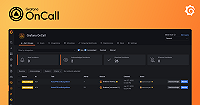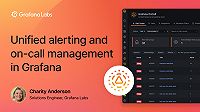Caution
As of 2025-03-11, Grafana OnCall OSS has entered maintenance mode, and will be archived on 2026-03-24. No further feature development will occur; however, we will still provide fixes for critical bugs and for valid CVEs with a CVSS score of 7.0 or higher. For more information, refer to our blog post.
Important: This documentation is about an older version. It's relevant only to the release noted, many of the features and functions have been updated or replaced. Please view the current version.
Grafana OnCall open source guide
Grafana OnCall is a developer-friendly incident response tool that’s available to Grafana open source and Grafana Cloud users. The OSS version of Grafana OnCall provides the same reliable on-call management solution along with the flexibility of a self-managed environment.
This guide describes the necessary installation and configuration steps needed to configure OSS Grafana OnCall.
Install Grafana OnCall OSS
There are three Grafana OnCall OSS environments available:
- Hobby playground environment for local usage: README.md
- Development environment for contributors: development README.md
- Production environment for reliable cloud installation using Helm: Production Environment
Production Environment
We suggest using our official helm chart for the reliable production deployment of Grafana OnCall. It will deploy Grafana OnCall engine and celery workers, along with RabbitMQ cluster, Redis Cluster, and the database.
Note: The Grafana OnCall engine currently supports one instance of the Grafana OnCall plugin at a time.
Check the helm chart for more details.
We’ll always be happy to provide assistance with production deployment in our communities!
Update Grafana OnCall OSS
To update an OSS installation of Grafana OnCall, please see the update docs:
- Hobby playground environment: README.md
- Production Helm environment: Helm update
Slack Setup
The Slack integration for Grafana OnCall leverages Slack API features to provide a customizable and useful integration. Refer to the following steps to configure the Slack integration:
Ensure your Grafana OnCall environment is up and running.
Grafana OnCall must be accessible through HTTPS. For development purposes, use localtunnel. For production purposes, consider establishing a proper web server with HTTPS termination. For localtunnel, refer to the following configuration:
# Choose the unique prefix instead of pretty-turkey-83
# Localtunnel will generate an url, e.g. https://pretty-turkey-83.loca.lt
# it is referred as <ONCALL_ENGINE_PUBLIC_URL> below
lt --port 8080 -s pretty-turkey-83 --print-requestsIf using localtunnel, open your external URL and click Continue to allow requests to bypass the warning page.
Create a Slack Workspace for development, or use your company workspace.
Go to https://api.slack.com/apps and click Create an App .
Select
From an app manifestoption and select your workspace.Replace the text with the following YAML code block . Be sure to replace
<YOUR_BOT_NAME>and<ONCALL_ENGINE_PUBLIC_URL>fields with the appropriate information.
Set environment variables by navigating to your Grafana OnCall, then click Env Variables and set the following:
SLACK_CLIENT_OAUTH_ID = Basic Information -> App Credentials -> Client ID SLACK_CLIENT_OAUTH_SECRET = Basic Information -> App Credentials -> Client Secret SLACK_SIGNING_SECRET = Basic Information -> App Credentials -> Signing Secret SLACK_INSTALL_RETURN_REDIRECT_HOST = << OnCall external URL >>In OnCall, navigate to ChatOps, select Slack and click Install Slack integration.
Configure additional Slack settings.
Telegram Setup
The Telegram integration for Grafana OnCall is designed for collaborative team work and improved incident response. Refer to the following steps to configure the Telegram integration:
- Ensure your Grafana OnCall environment is up and running.
- Create a Telegram bot using BotFather and save the token provided by BotFather. Please make sure to disable Group Privacy for the bot (Bot Settings -> Group Privacy -> Turn off).
- Paste the token provided by BotFather to the
TELEGRAM_TOKENvariable on the Env Variables page of your Grafana OnCall instance. - Set the
TELEGRAM_WEBHOOK_HOSTvariable to the external address of your Grafana OnCall instance. Please note thatTELEGRAM_WEBHOOK_HOSTmust start withhttps://and be publicly available (meaning that it can be reached by Telegram servers). If your host is private or local, consider using a reverse proxy (e.g. ngrok). - Now you can connect Telegram accounts on the Users page and receive alert groups to Telegram direct messages. Alternatively, in case you want to connect Telegram channels to your Grafana OnCall environment, navigate to the ChatOps tab.
Grafana OSS-Cloud Setup
The benefits of connecting to Grafana Cloud include:
- Cloud OnCall could monitor OSS OnCall uptime using heartbeat
- SMS for user notifications
- Phone calls for user notifications.
To connect to Grafana Cloud, refer to the Cloud page in your OSS Grafana OnCall instance.
Twilio Setup
Grafana OnCall supports Twilio SMS and phone call notifications delivery. If you prefer to configure SMS and phone call notifications using Twilio, complete the following steps:
- Set
GRAFANA_CLOUD_NOTIFICATIONS_ENABLEDas False to ensure the Grafana OSS <-> Cloud connector is disabled. - From your OnCall environment, select Env Variables and configure all variables starting with
TWILIO_.
Email Setup
Grafana OnCall is capable of sending emails using SMTP as a user notification step. To setup email notifications, populate the following env variables with your SMTP server credentials:
EMAIL_HOST- SMTP server hostEMAIL_HOST_USER- SMTP server userEMAIL_HOST_PASSWORD- SMTP server passwordEMAIL_PORT(default is587) - SMTP server portEMAIL_USE_TLS(default isTrue) - To enable/disable TLSEMAIL_FROM_ADDRESS(optional) - Email address used to send emails. If not specified,EMAIL_HOST_USERwill be used.
After enabling the email integration, it will be possible to use the Notify by email notification step in user settings.




